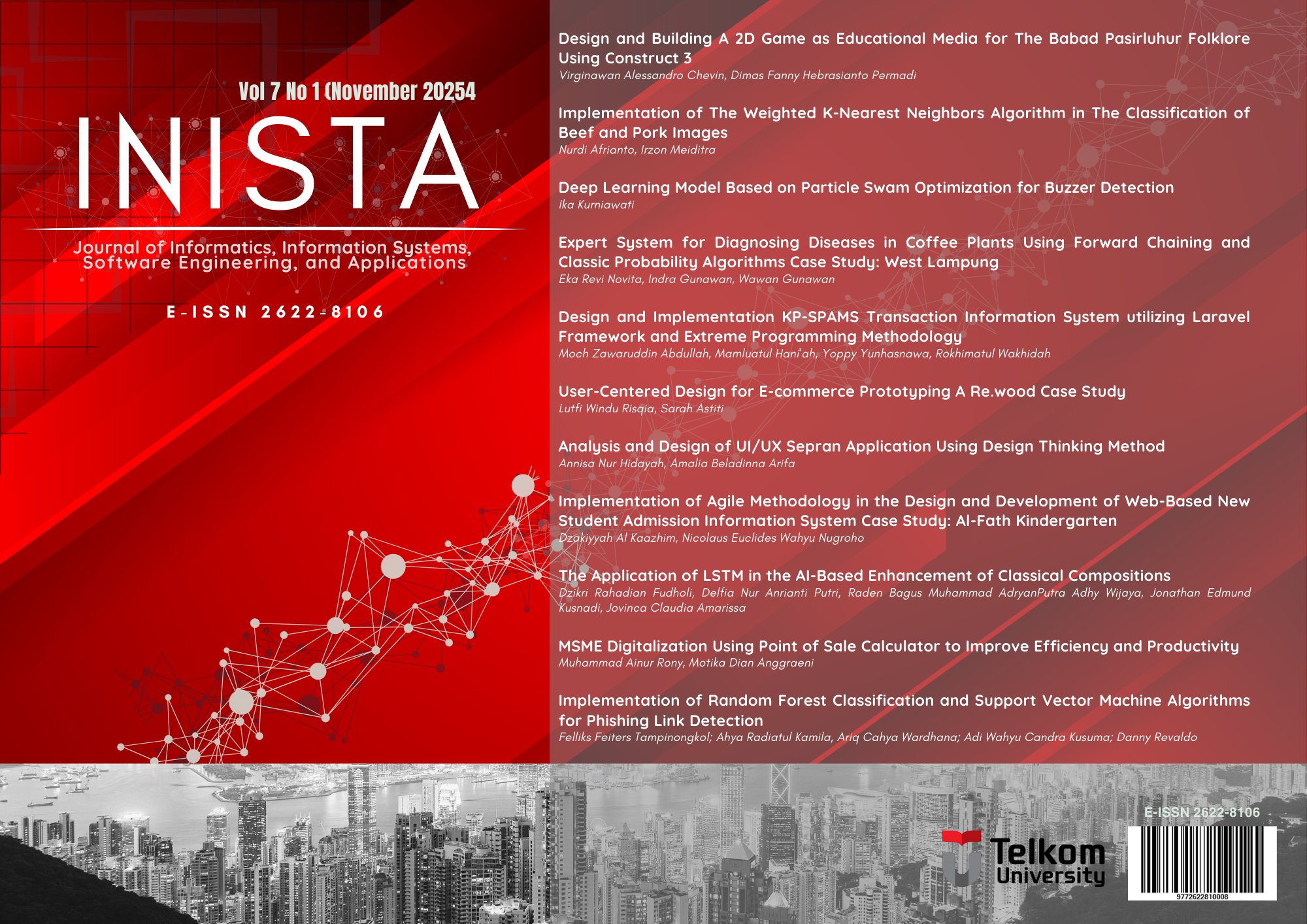Design and Building A 2D Game as Educational Media for The Babad Pasirluhur Folklore Using Construct 3
Main Article Content
Abstract
Folklore can also be called a part of Indonesian culture that tells about entertainment, history and culture from a region in Indonesia. Indonesian folklore has educational value and cultural elements that can be studied. One way of learning about folklore can be implemented through games. Games can be used as an educational media because apart from producing information they can also be entertainment for those who play them. Based on the background, we have conducted interviews with teachers at Public Elementary School 2 Purwokerto Lor and obtained results regarding the need for media to introduce folklore. In this elementary school, the folklore about Babad Pasirluhur is not yet understood by students. So we propose to design a 2D game as an educational media for the Babad Pasirluhur folklore implemented into adventure genre. Therefore, the aim of this research is to design an educational adventure game for the Babad Pasirluhur folklore using the Game Development Life Cycle (GDLC) method. This game was build using the Construct 3 game engine because suitable for simple adventure game. The resutls obtained were that black box method functional with a success score of 100% from 5 testers. Meanwhile, the UAT test obtained results of 84,7% from 33 grade 4 students at Public Elementary School 2 Purwokerto Lor. The UAT test results stated that it was included in the “strongly agree” category. These results have been tested using the normality test and one sample t-test and the concluesion is that H0 is rejected and H1 is accepted. So the results of this game can be accepted as a learning media for the Babad Pasirluhur folklore by grade 4 students at Public Elementary School 2 Purwokerto Lor. Suggestions for further development are needed to improve the design to suit the character of grade 4 students based on the results of the UAT testing on the design section which got the lowest score is 84%.
Article Details

This work is licensed under a Creative Commons Attribution-ShareAlike 4.0 International License.
Authors who publish with this journal agree to the following terms:
- Authors retain copyright and grant the journal right of first publication with the work simultaneously licensed under a Creative Commons Attribution License (CC BY-SA 4.0) that allows others to share the work with an acknowledgement of the work's authorship and initial publication in this journal.
- Authors are able to enter into separate, additional contractual arrangements for the non-exclusive distribution of the journal's published version of the work (e.g., post it to an institutional repository or publish it in a book), with an acknowledgement of its initial publication in this journal.
- Authors are permitted and encouraged to post their work online (e.g., in institutional repositories or on their website) prior to and during the submission process, as it can lead to productive exchanges, as well as earlier and greater citation of published work.
References
[2] A. Chusyairi, J. S. L. Wibowo, and A. K. Winata, “Game Gandrung Stories Untuk Edukasi Kebudayaan Menggunakan Metode GDLC,” JASIKA, vol. 1, no. 1, pp. 67-75, 2020.
[3] C. D. Irawan, D. J. Mamahit, and A. M. Sambul, “Pembuatan Game Simulasi Kewirausahaan untuk Profesi Petani,” Jurnal Teknik Informatika, vol. 14, no. 1, pp. 53-62, 2019.
[4] D. Tresnawati and I. Setyawan, “Rancang Bangun Game Bergenre Role Playing Game Cerita Rakyat Sangkuriang, “ Jurnal Algoritma, vol. 18, no. 1, pp. 231-236, 2021.
[5] R. Janata, A. T. Priandika, and R. D. Gunawan, “PENGEMBANGAN GAME PETUALANGAN EDUKASI PENGENALAN SATWA DILINDUNGI DI INDONESIA MENGGUNAKAN CONSTRUCT 2,” Jurnal Informatika dan Rekayasa Perangkat Lunak (JATIKA), vol. 3, no. 3, pp. 286-294, 2022.
[6] Y. Y. Merdiyatna, “STRUKTUR, KONTEKS, DAN FUNGSI CERITA RAKYAT KARANGMULYAN,” Jurnal Salaka, vol. 1, no. 2, pp. 38-45, 2019.
[7] W. D. Aulianti, S. A. Karim, and M. Riska, “Pengembangan Game Pendidikan Anti Korupsi Berbasis Android, “ Jurnal MediaTIK: Jurnal Media Pendidikan Teknik Informatika dan Komputer, vol. 4, no. 2, pp. 27-32, 2021.
[8] I. S. Noava and A. Putra, “Eksplorasi Etnomatematika pada Cerita Rakyat,”Plusminus: Jurnal Pendidikan Matematika, vol. 2, no. 1, pp. 67-76, 2022.
[9] A. G. Pradana and S. Nita, “Rancang Bangun Game Edukasi ‘AMUDRA’ Alat Musik Daerah Berbasis Android,” 2019.
[10] S. Ramdhani, N. A. Yuliastri, S. D. Sari, and S. Hasriah, “Penanaman Nilai-Nilai Karakter melalui Kegiatan Storytelling dengan Menggunakan Cerita Rakyat Sasak pada Anak Usia Dini,” Jurnal Obsesi: Jurnal Pendidikan Anak Usia Dini, vol. 3, no. 1, pp. 153-160, 2019.
[11] R. R. Pradana and A. Surahman, “PERANCANGAN APLIKASI GAME FIGHTING 2 DIMENSI DENGAN TEMA KARAKTER NUSANTARA BERBASIS ANDROID MENGGUNAKAN CONSTRUCT 2,” Jurnal Informatika dan Rekayasa Perangkat Lunak, vol. 1, no. 2, pp. 234-244, 2020.
[12] Mustofa, J. L. Putra, and C. Kesuma, “Penerapan Game Development Life Cycle Untuk Video Game Dengan Model Role Playing Game,” Computer Science (CO-SCIENCE), vol. 1, no. 1, pp. 27–34, 2021.
[13] T. Arianti, A. Fa’izi, S. Adam, and M. Wulandari, “Perancangan Sistem Informasi Perpustakaan Menggunakan Diagram UML(Unified Modelling Language),” Jikti: Jurnal Ilmiah Komputer Terapan dan Informasi, vol. 1, no. 1, pp. 19–25, 2022.
[14] B. Priyatna, A. L. Hananto, and M. Nova, “Application of UAT (User Acceptance Test) Evaluation Model in Minggon E-Meeting Software Development,” SYSTEMATICS, vol. 2, no. 3, pp. 110–117, 2020.
[15] M. M. Khaer and N. N. Pusparini, “Analisis Kartu Access Control Pintu Menggunakan Metode User Acceptance Test pada Museum Bank Indonesia,” EBID:Ekonomi Bisnis Digital, vol. 1, no. 2, pp. 219–230, Dec. 2023, doi: 10.37365/ebid.v1i2.227.
[16] R. N. Ichsan and A. Karim, “Kualitas Pelayanan Terhadap Kepuasan Nasabah PT. Jasa Raharja Medan,” Jurnal Penelitian Pendidikan Sosial Humaniora, vol. 6, no. 1, pp. 54–57, 2021.
[17] M. Dewi, T. Wahyuningrum, and N. A. Prasetyo, “Pengenalan Kata Bahasa Isyarat Indonesia (BISINDO) Menggunakan Augmented Reality (AR),” INISTA, vol. 3, no. 2, pp. 53–060, 2021, doi: 10.20895/INISTA.V3I2.
